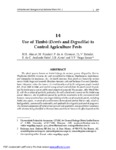Please use this identifier to cite or link to this item:
http://www.alice.cnptia.embrapa.br/alice/handle/doc/979644| Title: | Use of timbó (Derris and Deguellia) to control agriculture pests. |
| Authors: | ALECIO, M. R.  FAZOLIN, M.   OLIVEIRA, P. de A.   ESTRELA, J. L. V.   ANDRADE NETO, R. de C.   ALVES, S. B.   VEIGA-JUNIOR, V. F.   |
| Affiliation: | MURILO FAZOLIN, CPAF-AC JOELMA LIMA VIDAL ESTRELA ROMEU DE CARVALHO ANDRADE NETO, CPAF-AC. |
| Date Issued: | 2014 |
| Citation: | In: GUPTA, V. K. (ed.). Medicinal plants: phytochemistry, pharmacology and therapeutics. New Delhi: Daya Publishing House, 2014. |
| Pages: | p. 309-316. |
| Description: | The plant species known as timbó belongs to various genera (Deguellia, Derris, Thephrosia, Millettia, Serjania,etc.) and several families(Fabaceae, Papilionaceae, Sapindaceae, and Compostae Cariocaraceae, etc.). In South America, these plants are known by various names: timbó,tingui and cunambi(BrazilianAmazon); cube and barbasco (Peru andColombia), haiari (Guyana), nekoe(Suriname); it istraditionally used by theindigenous peopleto catch fish. From 1880 to 1940, pest control using extracts and oils from the plant was at its peak, and thetimbó species was one of the most important groupsforthis purpose. After World War II, with the creation of synthetic pesticides, the mills closed and research on the timbó crop ceased. However, due to problems caused by synthetic insecticides to the environment and humans, many scientists have now begun looking into the use of insecticide plants, including timbó, once again, in search of new alternative forms of pest control that are safe, selective, biodegradable, economically sustainable, and applicableto integrated pest control programs. The chemical composition oftimbó extracts present wide qualitative and quantitative variations, with rotenone being identified asthe main toxic constituent; howeveritseffect depends on the combined action of other compounds. This chapter presentstheresults ofresearch on the use of extracts and powdered roots of timbó for pest control in agriculture,emphasizing its biological effects on animals. It also contextualizesthe need of morescientific effortsto determinethe best combination of compounds present in the plants, in orderto increasetheireffectivenessin pest control. |
| Thesagro: | Timbó |
| Keywords: | Controle de praga Inseticida natural |
| Series/Report no.: | (Utilization and management of medicinal plans, v. 2). |
| Type of Material: | Parte de livro |
| Access: | openAccess |
| Appears in Collections: | Capítulo em livro científico (CPAF-AC)  |










